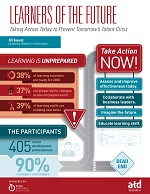ATD Blog
How Technologies Will Change the Learning Function’s Role
Tue Dec 22 2015


Envisioning the future of talent development, and the workers who will need training in 2020 and beyond, calls on talent development leaders to artfully apply business savvy, learning know-how, and sheer imagination. A backward glance at the extensive changes seen during the past decade alone in world markets, organizational operations, and learning design and delivery methods portends a rapidly approaching future that is both exciting and daunting to anticipate.
Indeed, when the Association for Talent Development (ATD) and the Institute for Corporate Productivity (i4cp) partnered to explore Learners of the Future: Taking Action Today to Prevent Tomorrow’s Talent Crisis, a robust 59 percent of talent development leaders surveyed said that in 2020, “learning will take place in ways we can’t imagine today.”
This latest ATD and i4cp research collaboration found that the majority of organizational learning functions are not effectively leveraging technologies to support their ability to achieve business goals or L&D objectives. Those lagging capabilities don’t negate the fact that technology-enabled learning products and strategies play increasingly important roles in designing and delivering content to learners worldwide. Technology will play an even greater role in the future.
For instance, as mobile devices continue to proliferate, global studies estimate more than 2 billion people will be regular smartphone users by 2018 (eMarketer 2014). That same year is expected to see tablet users exceeding 1.4 billion (eMarketer 2015). Accordingly, reports by eLearningIndustry.com estimate growth in the mobile learning market to be more than 18 percent per year, and growth in self-paced e-learning to be more than 9 percent. Online training and social learning also are on the rise (Pappas 2015).
“We’re using a variety of ways to deliver learning with a particular emphasis on the latest technologies, including mobile,” says Frank Persico at IBM. “We have an initiative called Mobile First. Many companies come to mobile by developing content in a way that is not easily accessible through mobile devices. Our Mobile First idea is that we actually go into design assuming that the mobile approach will be the primary delivery mode. So mobile is part of learning content design from the outset.”
The Study asked respondents to anticipate how increases in learning speed, efficiency, and accessibility brought about by technological innovations might affect the role of organizational learning functions in coming years. By far, the most popular responses had L&D tracking employee learning (74 percent) and assessing learning effectiveness (73 percent).
Blending internal and external content for learning, creating individual learning plans for employees, and delivering customized content tailored to learners’ preferences were the next most highly rated choices, although all three trailed the measurement-related options by more than 10 percentage points.
That a future L&D function would be inclined to first apply technology to measurement suggests the perception of an ongoing need to provide data that justifiy learning or communicate its value. That reasoning would imply that such responses could link to market performance, but the Study findings do not support that conclusion.
Rather, the only significant correlations to market performance were found with creating internal content customized to individual learning plans, creating those individual plans, and identifying appropriate external learning assets—all actions specifically tied to providing learning versus tracking it. Further, those three activities were the only responses correlated to all three indices used in the Study, so they also linked to learning effectiveness and future readiness. Consequently, better bottom line and learning performance is more likely to be associated with actually doing learning than measuring it.
For more insights, check out Learners of the Future: Taking Action Today to Prevent Tomorrow’s Talent Crisis.
Figure: TECHNOLOGY WILL TURN L&D INTO LEARNING TRACKERS
Technology has enhanced learning efficiency, speed, and accessibility. As this evolution continues and learning becomes more self-directed, to what extent will the following characterize the role of the learning function?
Track employee learning; 74%
Assess learning effectiveness; 73%
Use a blend of internal and external content; 63%
Create individual learning plans to provide focus for employees; 60%
Deliver content customized to individuals’ learning preferences (live, mobile, microlearning, and so on); 60%
Curate learning content (internal and external); 59%
Identify appropriate learning assets available externally; 57% Create learning content internally to provide employees with assets customized to their individual learning plans; 53%
Partner with learning vendors to create or adapt organization-specific learning assets; 53%
Assess quality of externally available programs; 52%
Recommend or approve specific external programs to address organizational learning needs; 52%
Internally create collections of generic learning programs that address specific topics; 41%
